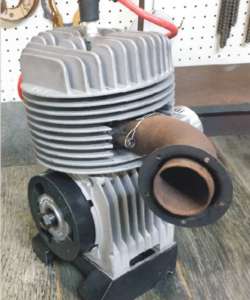


Capacity: 100cc Air cooled
Stroke: 48.5mm
Rod length 96mm
Bores Size: 51.00mm 2.004"
Piston Size: 50..90mm 2.008"
Clearance: 4 thou
Ex = 178deg
Tran = 128deg
Boost = 130deg
Valve close = 71 deg
Valve open = 130deg
RV clearance = 12thou
End Play = 10 thou
Timing = 2.3mm
Squish = 1.0 - 1.1mm
Combustion chamber = 8.6cc
Compression Ratio = 11.6 : 1
RPM limit 18,400rpm
Stroke: 48.5mm
Rod length 96mm
Bores Size: 51.00mm 2.004"
Piston Size: 50..90mm 2.008"
Clearance: 4 thou
Ex = 178deg
Tran = 128deg
Boost = 130deg
Valve close = 71 deg
Valve open = 130deg
RV clearance = 12thou
End Play = 10 thou
Timing = 2.3mm
Squish = 1.0 - 1.1mm
Combustion chamber = 8.6cc
Compression Ratio = 11.6 : 1
RPM limit 18,400rpm
This engine was built as a National
Class Engine. In Australia that was "Class Australia." Eligibility
was 25.4mm carby, 8.5cc Combustion Chamber, Rotary Valve engines with 2 transfers and
a 3rd boost port fed through a window in the piston, or any Piston Port engine. Port modifications and tuning allowed. The low
compression made the engine easy to tune and they ran with great
reliability. Exotic fuels not needed.
I set to work on this engine and it is very highly modified. Won every class Australia meeting I ran it at. But along came the reed valve engines and the class numbers dwindled. So in the 1990's at club level a "Formula A "class was introduced. The eligibility being any 100cc engine, 25.4mm carby, and Dunlop SL4 Tyres. I ran this engine to the first "Formula A" club championships held over 6 rounds. Up against Rotax DSB's and Reeds, Parilla TT36's and TT75's, PCR TS50/3's, Atomik's and so on.
Every surface is dimensionally true and square. Every clearance and tolerance correct. Took a lot of time doing this. I then gave this engine big port timings, enlarged the boost port enormously (still 100% feed through the piston) lots of valve timing without being radical, much enlarged inlet and a Tillotson HL360 carby with a waifer thin butterfly setup. I was tempted to increase the compression ratio but it has real jump out of the corner and revved so hard it wasn't necessary. It all worked really well on premium pump petrol with TTS at 30:1. The reason this engine works so well is it has the best Crankcase compression ratio and is tuned and setup to take advantage of that. I robbed the motoplat of this engine for another brand engine of the era and replaced with a New Ducati ignition system made for PCR. I ran this engine recently and its race ready. Perfect.
I set to work on this engine and it is very highly modified. Won every class Australia meeting I ran it at. But along came the reed valve engines and the class numbers dwindled. So in the 1990's at club level a "Formula A "class was introduced. The eligibility being any 100cc engine, 25.4mm carby, and Dunlop SL4 Tyres. I ran this engine to the first "Formula A" club championships held over 6 rounds. Up against Rotax DSB's and Reeds, Parilla TT36's and TT75's, PCR TS50/3's, Atomik's and so on.
Every surface is dimensionally true and square. Every clearance and tolerance correct. Took a lot of time doing this. I then gave this engine big port timings, enlarged the boost port enormously (still 100% feed through the piston) lots of valve timing without being radical, much enlarged inlet and a Tillotson HL360 carby with a waifer thin butterfly setup. I was tempted to increase the compression ratio but it has real jump out of the corner and revved so hard it wasn't necessary. It all worked really well on premium pump petrol with TTS at 30:1. The reason this engine works so well is it has the best Crankcase compression ratio and is tuned and setup to take advantage of that. I robbed the motoplat of this engine for another brand engine of the era and replaced with a New Ducati ignition system made for PCR. I ran this engine recently and its race ready. Perfect.
